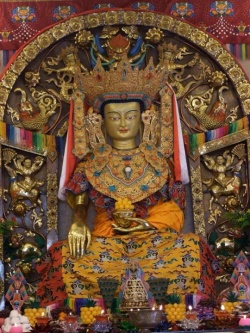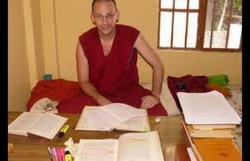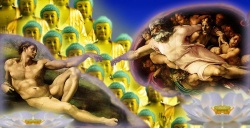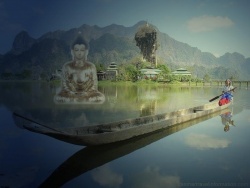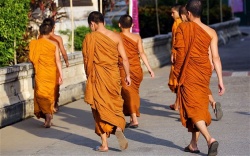Difference between revisions of "The History of Korean Buddhism"
(Created page with " ===The Three Kingdoms Era (BC 39 – AD 668)=== When Buddhism was first introduced to Korea, the peninsula of Korea was divided into the three kingdoms ...") |
|||
| Line 1: | Line 1: | ||
| − | + | {{DisplayImages|4185|2313|4374|2570|208|4225|3976|3316}} | |
===The [[Three Kingdoms Era (BC 39 – AD 668)]]=== | ===The [[Three Kingdoms Era (BC 39 – AD 668)]]=== | ||
Revision as of 08:34, 6 February 2015
The Three Kingdoms Era (BC 39 – AD 668)
When Buddhism was first introduced to Korea, the peninsula of Korea was divided into the three kingdoms of Goh Goo Ryur (BC 37 – AD 668), Baek Jeh (BC 18 – AD 660), and Sil Lah (BC 57 –AD 935).
First Kingdom
Officially, Buddhism became accepted in Goh Goo Ryur in the second year of King Soh Soo Rim’s reign (AD 372) through the acquisition of Buddha images and sutras from Soon Do Snim, a monk who came from Eastern China. But privately, Buddhism was already well known to the people of Goh Goo Ryur earlier. So, Goh Goo Ryur’s official acceptance of Buddhism as a national ideology was, in the first place, to sanctify the power of sovereignty and to control the people.
Second Kingdom
Twelve years later, in the first year of King Chim Ryoo’s reign (AD 384) an Indian monk known as Marananda brought Buddhism to Baek Jeh. The royal court of Baek Jeh actively propagated Buddhism through the next reigning monarch, King Ah Shin, who declared to the people that they should obtain good fortune by believing in Buddhism. Baek Jeh also greatly contributed to the development of ancient Japan by spreading Buddhism to this neighbouring country. King Surng Myung, for example, sent envoys to Japan with a stone Buddha image and Buddhist scriptures. Korean monks like Dahm Hyeh had great influence on the establishment of early Buddhism in Japan, too, through visists and by building temples there.
Third Kingdom
The third kingdom, Sil Lah, officially accepted Buddhism in AD 527 about 150 years later than Goh Goo Ryur and Baek Jeh. At the beginning this effort was met with great difficulties because of Sil Lah’s weak sovereign power on the one hand and, on the other hand, a relatively strong aristocracy which still adhered to the local religions. But on the occasion of the martyrdom of the Royal Minister Ee Chah Don, the Sil Lah court finally accepted Buddhism in the 14th year of King Burp Huhng’s rule in AD 527.
The reason why Buddhism could develop quickly under the three kingdoms' royal patronage was that in these ancient nations the royal authority was the centre of the nation’s power and Buddhism suited fine as a spiritual support for this power base.
The name of this temple is “Bul Guk Sa” which means “Buddha Land.” First built in AD 535 during the reign of King Beop-heung, it is located on the outskirts of Gyung-ju, the capital of the unified Sil Lah period. The present stucture of this temple stems from its rebuilding during the reign of King Gyong-dok (AD 742 – 765). The restructuring was carried out by Kim Dae-seong, a famous prime minister who is historically well known.
The above Buddha statue, named “Surk Gul Ahm”, means “cave of the Buddha”. It was created at the same time as Bul Guk Sa temple - about AD 751 by the famous Kim Dae-seong. The Surk Gul Ahm is said to be one of the most beautiful Buddha statues in the world.
Unified SilLah (AD 668 – 935)
Sil Lah adopted Buddhism as a ruling theory to solidify its own sovereignty. Sil Lah united the three kingdoms after defeating its neighbour countries Goh Goo Ryur and Baek Jeh in the 8th year of King Moon Moo’s reign.
As the national religion, Buddhism played a great spiritual role in this unified country, the Unified Sil Lah. At the beginning, it was mainly the aristocracy that embraced Buddhism but eventually more and more ordinary people also came to know it and to believe in it.
During this period, Buddhism in the Unified Sil Lah was mainly dominated by personalities like the great monks Won Hyo, Ui Sang, and Cha Jang. These three monks are representative for many other eminent monks who helped to turn the Unified Sil Lah time into the golden age of Korean Buddhism.
During these early years five main schools of Doctrinal Buddhism emerged:
1. Vinaya School (Yul Jong),
2. Nirvana School (Yeol-ban Jong),
3. Dharma Nature School (Beob-seong Jong),
4. Avatamska School (Hwaurm Jong), and
5. Yogacara School (Beob-sang Jong).
These early schools were to play a fundamental role in the future development of Korean Buddhism and they finally blossomed into radiant Korean Buddhist legacies such as the famous Surk Gul Ahm Cave, Bul Guk Sa Temple, etc.
The Introduction of Zen Buddhism to Korea
(The Nine Mountain Schools of Korean Zen)
In Korea Zen was first introduced by the monk Toui. He, a native of Sil Lah, went to China in 784 (at the time of the Tang Dynasty) and returned in 818 after a stay of thirty four years.
Toui was born at a time when Buddhist culture in Sil Lah had already passed its zenith and was entering a period of decline. Toui’s lifetime also happened to coincide with the golden age of Zen Buddhism in China (roughly the 8th and 9th century).
During his stay in China, the monk Toui studied under the renowned Zen master Hsi Tang Chih Tsang (735 – 814). Along with Nan Chuan (748 – 835) and Pai Chang (720 – 814) Hsi Tang was considered to be one of the ablest of the 139 Dharma heirs of the great patriarch Ma Tsu (709 – 788).
From Zen master Hsi Tang Chih Tsang (Kor.: Seo-Dang Ji-Jang) the monk Toui received the `Transmission of Dharma´. Toui’s enlightenment was also recognized by Pai Chang, who is said to have praised him by saying: “It seems that the orthodox Zen tradition of master Ma Tsu will soon leave China and cross the sea to Sil Lah”.
At the same time as Toui, several other Korean monks also studied Zen in Tang China. These monks later returned to Sil Lah and founded their own schools and temples. Following the Chinese tradition of the Tang Era these monks established their temples in the mountains. Hence they were called “Mountain Schools”. Nine of these Mountain Schools, which were all established within a period of one hundred years after Toui’s return from China (between 828 and 931), were especially famous. They are referred to as "The Nine Mountain Schools."
In sharp contrast to the Zen Buddhism that Toui and the other founding monks brought from China, Korean Buddhism had been, up to that time, completely sutra oriented. So, for example, Ui Sang’s Hwa Om School (School of the Avatamsaka doctrine) had become the most prosperous and most influential sect of all the doctrinal schools and therefore exercised the greatest influence on the scholastic orientation of the Sil Lah Buddhism.
In this situation, the monk Toui became the first Zen master in Korea to openly challenge the supremacy, indeed even the validity, of the doctrinal schools. During the next hundred years the distinction between Zen and the doctrinal schools came to be more sharply drawn in Korea than it had ever been in China.
The Buddhism of the Goh Ryur Dynasty (935 – 1392)
Wang Geon, the founder of the Goh Ryur dynasty who assumed power under the name King Tae Jo (918 – 943), was a devout Buddhist and was personally befriended with many Zen monks. He thought that the establishment of the Goh Ryur Dynasty was only possible because of the blessing of the Buddha. So he protected Buddhism and built many temples.
Meanwhile the Zen sect, which had been introduced to Korea in the later Unified Sil Lah period and had then developed on its own during the time of the Goh Ryur dynasty, began more and more to define Korean Buddhism.
As with Sil Lah, Buddhism in the Goh Ryur period was also considered to be a religion which protected the nation. Because of the geographic situation neighbouring countries frequently invaded Goh Ryur. The carving of the enormous Buddhist canon on eighty-four-thousand wooden blocks was carried out as a means to defend the country against foreign invasions by invoking the power of the Buddha’s teachings. Another motivation for this mammoth task of carving was to resolve the conflicts between the Seon (Zen) and the the Gyo (doctrine) schools. This carving task was begun in the early years of the eleventh centry during the reign of King Hyon Jong (1011) and was completed in the 4th year of King Seonjong (1087), stretching out over the long period of 77 years. However, these wooden blocks were unfortunately burned during the Mongol invasions in the 19th year of King Go Jong (1232). Hence, in the 23rd year of King Go Jong (1236) the historical carving task of the Tripitaka was started again and the great Buddhist canon equivalent to 81258 wooden blocks was finally completed in the 38th year of King Go Jong (1251).
The carving of the Buddhist canon of eighty-thousand was one of the great achievements of Go Ryur Buddhism, indeed of all Korean Buddhism, and it is still well preserved in the Jang Gyong Gak of the Hae In Sa temple.
The first carving of the Tripitaka was supported by the monk Uichon (the National Teacher Dae-gak) for the publication of Buddhist Scriptures. Uichon, a seminal figure in Korean Buddhist history, was the first person to attempt a reconciliation between the two schools of Seon and Gyo. Uichon was the fourth son of King Munjong (1046 – 1083) and became a monk against his father's wishes, travelling surreptitiously to Sung China in 1085 at the age of thirty. Upon his return from China, Uichon tried to reconcile the conflicts between the Seon and the Gyo schools. But he died at the early age 46 and the experiment was brought to a halt. The task was left to be completed by Zen master National Teacher Bojo Jinul (1158 – 1210). Bojo Jinul is to Korean Zen what Hui-neng, the sixth Patriarch, is to Chinese Zen.
Joh Surn Dynasty, alias the Yi Dynasty (1392 – 1910)
Buddhism under the Yi Dynasty
Yi Taejo (1392 – 1398), the founder of the new dynasty, personally was a Buddhist who had been converted to Buddhism by Muhak Daesa who was a successor of Zen Master Naong Hye Geun (1320 – 1376, the last years of the Goh Ryur dynasty), but he politically owed his power to the Neo-Confucianists. He adapted Buddhism as a simple religion and Confucianism as a social-administrative system. As a result, the measures against Buddhist establishments were primarily economic and were neither too severe nor too lenient.
But this policy changed under the third king of the Yi dynasty, Taejong (1400 – 1418), who was a younger son of Taejo. Taejong moved steadily to reduce the economic, political, and social influence of Buddhism and increasingly promoted the ideas of Neo-Confucianism.
Finally, they actively began to suppress Buddhism. This was closely related to the corrupt sovereigns and bureaucrats of Goh Ryur who had become so corrupt that no one could effectively wield great influence upon them at that time. This anti-Buddhism-policy of the Yi dynasty continued for almost 500 years.
Despite this official oppression, Buddhism still played a religious role in all realms of society. The most famous example came during the Japanese invasion of the late 16th century, when Buddhist masters like Hyoo Jurng (Seo San Dae Sa) organised monks into a fighting force to save the Korean race and expelled the invaders from the country. Contrary to the leaders' intentions of this time, Buddhism became even move deeply entrenched in common people's culture and belief systems.
During the Japanese occupation (1910 – 1945) the distorted influence of Japanese Buddhism drew a dark shadow over Korean Buddhism which increasingly lost its identity because of Japanese political oppression. Due to the corrupted system many temples were run by married monks.
After Korea gained independence in 1945 the government took the lead to expel married monks from temples, so bhikkhus and bhikkunis regained their previous positions and Korean Buddhism reached a new turning point. Since then the tradition of the Jogye order, the representative Korean Buddhist order, has been re-established. In an effort to re-establish independence and self-reliance, Buddhists in Korea consolidated themselves and tried to clean up their own monasteries which had been severely weakened by the impositions of the Japanese colonizers.
An example of this is the Buddhist Clearing-Up Movement in the 1950s, which was a development of the renewed Buddhism in Korea and was conducted by the monastic Sangha as well as lay followers.
The Zen school also had a favorable influence upon reforming the Korean Buddhist spirit, which had been changed into the style of Japanese Buddhists, in Post-Japanese Korea (after Korea's liberation from the reign of Japan). Zen has always blown fresh air into Korean Buddhism whenever it had fallen into its own contradictions and needed some help for salvation.
Hence, “the aspect of Korean Buddhism, which has preserved the original spirit of the Buddha, which takes a serious view of the tradition and rules of unified Buddhism, which sees Seon (Zen) and Doctrine as one, is still alive in modern Buddhism”.
